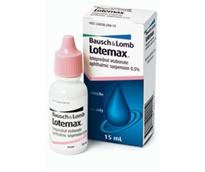Loteprednol ophthalmic Side Effects
Medically reviewed by Drugs.com. Last updated on Oct 3, 2023.
Applies to loteprednol ophthalmic: ophthalmic gel/jelly, ophthalmic ointment, ophthalmic suspension.
Serious side effects
Along with its needed effects, loteprednol ophthalmic may cause some unwanted effects. Although not all of these side effects may occur, if they do occur they may need medical attention.
Check with your doctor immediately if any of the following side effects occur while taking loteprednol ophthalmic:
More common
- Blurred vision or other change in vision
- redness or swelling of the eye
- sensitivity of the eyes to light
- swelling of the membrane covering the white part of the eye
Less common
- Decreased vision
- discharge from the eye
- eye discomfort, irritation, or pain
- redness of the eyelid or inner lining of the eyelid
- tiny bumps on the inner lining of the eyelid
Incidence not known
- Blindness
- gradual blurring or loss of vision
- loss of vision
- nausea
- slow wound healing
- tearing
- vomiting
Other side effects
Some side effects of loteprednol ophthalmic may occur that usually do not need medical attention. These side effects may go away during treatment as your body adjusts to the medicine. Also, your health care professional may be able to tell you about ways to prevent or reduce some of these side effects.
Check with your health care professional if any of the following side effects continue or are bothersome or if you have any questions about them:
More common
- Burning feeling when medicine is applied
- dry eyes
- feeling of something in the eye
- headache
- itching
- runny nose
- sore throat
For Healthcare Professionals
Applies to loteprednol ophthalmic: ophthalmic gel, ophthalmic ointment, ophthalmic suspension.
General
The most common reported side effects were anterior chamber inflammation, eye pain, and foreign body sensation.[Ref]
Ocular
Common (1% to 10%): Corneal defect, eye discharge, ocular discomfort, dry eye, epiphora, foreign body sensation in eyes, conjunctival hyperemia, ocular itching, burning on instillation
Uncommon (0.1% to 1%): Abnormal vision, blurring of vision, chemosis, conjunctivitis, conjunctival hyperemia, iritis, eye irritation, eye pain, conjunctival papillae, photophobia, uveitis, keratoconjunctivitis
Frequency not reported: Elevated intraocular pressure, optic nerve damage, visual acuity and field defects, posterior subcapsular cataract formation[Ref]
Dermatologic
Rare (less than 0.1%): Urticaria, rash, dry skin, eczema[Ref]
Gastrointestinal
Rare (less than 0.1%): Diarrhea, nausea, vomiting[Ref]
Genitourinary
Rare (less than 0.1%): Urinary tract infection, urethritis[Ref]
Metabolic
Rare (less than 0.1%): Weight gain[Ref]
Nervous system
Rare (less than 0.1%): Migraine, taste perversion, dizziness, paresthesia, tinnitus[Ref]
Oncologic
Rare (less than 0.1%): Breast neoplasm[Ref]
Other
Uncommon (0.1% to 1%): Asthenia
Rare (less than 0.1%): Chills, fever, pain, face edema
Frequency not reported: Delayed wound healing[Ref]
Psychiatric
Rare (less than 0.1%): Nervousness[Ref]
Respiratory
Uncommon (0.1% to 1%): Rhinitis, pharyngitis
Rare (less than 0.1%): Chest pain, cough[Ref]
More about loteprednol ophthalmic
- Check interactions
- Compare alternatives
- Pricing & coupons
- Reviews (36)
- Side effects
- Dosage information
- During pregnancy
- Drug class: ophthalmic steroids
- Breastfeeding
- En español
Patient resources
- Loteprednol ophthalmic drug information
- Loteprednol (Advanced Reading)
- Loteprednol Eye Drops 0.2%
- Loteprednol Eye Drops 0.5% and 1%
- Loteprednol Eye Gel
- Loteprednol Eye Ointment
Other brands
Lotemax, Eysuvis, Lotemax SM, Alrex, Inveltys
Professional resources
Other brands
Lotemax, Eysuvis, Alrex, Inveltys
Related treatment guides
References
1. Product Information. Lotemax (loteprednol ophthalmic). Bausch and Lomb. 2001;PROD.
2. Product Information. Alrex (loteprednol ophthalmic). Bausch and Lomb. 2001;PROD.
3. Cerner Multum, Inc. UK Summary of Product Characteristics.
Further information
Always consult your healthcare provider to ensure the information displayed on this page applies to your personal circumstances.
Some side effects may not be reported. You may report them to the FDA.

